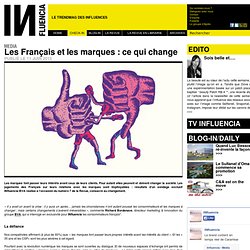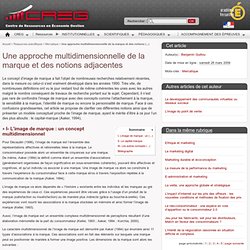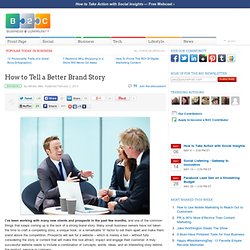

Media - Les Français et les marques : ce qui change. Publié le 11 juin 2013 Les marques font passer leurs intérêts avant ceux de leurs clients.

Pour autant elles peuvent et doivent changer la société. Les jugements des Français sur leurs relations avec les marques sont impitoyables : résultats d’un sondage exclusif INfluencia-BVA réalisé à l’occasion du numéro 7 de la Revue, consacré au changement. « Il y avait un avant la crise : il y aura un après… jamais les circonstances n’ont autant poussé les consommateurs et les marques à changer ; mais certains changements s’avèrent irréversibles », commente Richard Bordenave, directeur marketing & innovation du groupe BVA, qui a interrogé en exclusivité pour INfluencia les consommateurs français*. La défiance Nos compatriotes affirment (à plus de 60%) que « les marques font passer leurs propres intérêts avant les intérêts du client ». Pourtant avec la révolution numérique les marques se sont ouvertes au dialogue. Des marques à l’écoute Suite de l’enquête dans le document pdf ci-dessous. La rédaction.
The Power Of Brighter Naming. Branding In a Troubled Economy. Understanding the language of branding. A brand audit on the l’oréal brand. How to Write a Brand Plan. Une approche multidimensionnelle de la marque et des notions adjacentes. I- L’image de marque : un concept multidimensionnel Pour Décaudin (1996), l’image de marque est l’ensemble des représentations affectives et rationnelles liées à la marque.

Le consommateur possède alors un ensemble de croyances sur une marque. De même, Aaker (1994) la définit comme étant un ensemble d’associations (généralement organisées de façon significative en sous-ensembles cohérents), pouvant être affectives et cognitives, et qu’un individu va associer à une marque. Une image de marque va alors se construire à travers l’expérience du consommateur face à cette marque et/ou à travers l’exposition répétée à la communication de la marque (Aaker, 1994). L’image de marque va alors dépendre de « l’histoire » existante entre les individus et les marques au gré des expériences de ceux-ci.
Aussi, l’image de marque est un ensemble complexe multidimensionnel de perceptions résultant d’une élaboration mémorielle de la part du consommateur (Keller, 1993 ; Aaker, 1994 ; Korchia, 2000). How to Tell a Better Brand Story. I’ve been working with many new clients and prospects in the past few months, and one of the common things that keeps coming up is the lack of a strong brand story.

Many small business owners have not taken the time to craft a compelling story, a unique hook, or a remarkable “it” factor to set them apart and make them stand above the competition. Prospects will ask for a website – which is merely a tool – without fully considering the story or content that will make this tool attract, impact and engage their customer. A truly successful website needs to include a combination of concepts, words, ideas, and an interesting story behind the product, service or company. Finding Your Hook The key to finding your hook is focused reflection. Here are some examples that have come up recently in my consulting, which may inspire you to find the hook in your own business: How to Write a Brand Plan « Beloved Brands. A smart Brand Plan gets everyone in your organization on the same page, all driving against the same vision, key issues, strategies, and tactics.

Have you ever notice that those people who say “we need to get everyone on the same page” rarely have ONE page? People who use the term “few bigger bets” always seem to be fans of those small little projects that deplete resources. And, the person who says they are “good at decision-making” usually struggle when facing a decision and then try to justify both options. A smart Brand Plan should focus and organize the team. Allocation of your limited resources A smart Brand Plan makes choices in how to allocate your brand’s limited resources to drive the biggest return.
An effective Brand Plan answers where are we, why are we here, where could we be, how can we get there and what do we need to do.